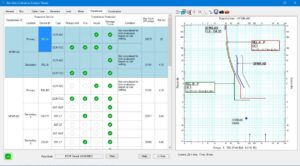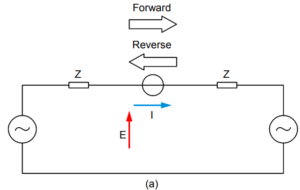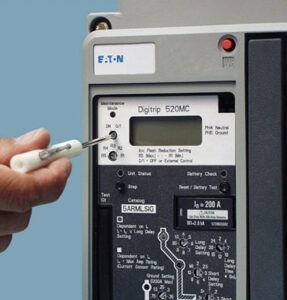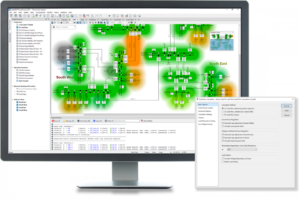This article provides a broad classification of the causes and impact of power quality problems that may occur on a power system, some typical causes of them and the potential impact on equipment.
The electricity supply waveform, often thought of as composed of pure sinusoidal quantities, can suffer a wide variety of disturbances.
Voltage Dips

Above image shows the profile of a voltage dip, together with the associated definitions.
The major cause of voltage dips on a supply system is a fault on the system, that is sufficiently remote electrically that a voltage interruption does not occur.
Other sources are the starting of large loads (especially common in industrial systems), and, occasionally, the supply of large inductive loads.
Voltage dips due to the latter are usually due to poor design of the network feeding the consumer.
A voltage dip is the most common supply disturbance causing interruption of production in an industrial plant.
Faults on a supply network will always occur, and in industrial systems, it is often practice to specify equipment to ride-through voltage dips of up to 0.2s.
The most common exception is contactors, which may well drop out if the voltage dips below 80% of rated voltage for more than 50-100ms.
Since contactors are commonly used in circuits supplying motors, the impact of voltage dips on motor drives, and hence the process concerned, requires consideration.
Voltage Surges / Spikes
Voltage surges/spikes are the opposite of dips – a rise that may be nearly instantaneous (spike) or takes place over a longer duration (surge).
These are most often caused by lightning strikes and arcing during switching operations on circuit breakers/contactors (fault clearance, circuit switching, especially switch-off of inductive loads).
Below figure shows the profile of a voltage surge:

Equipment may suffer serious damage from these causes, ranging from insulation damage to destruction of sensitive electronic devices.
The damage may be immediate and obvious by the fact that equipment stops working, through to failure at a much later date from deterioration initiated from a surge or spike of voltage.
These latter failures are very difficult to distinguish from random failures due to age, minor manufacturing defects, etc.
Overvoltage
Sustained over voltages are not common. The most likely causes are maladjusted voltage regulators on generators or on-load tap changers, or incorrectly set taps on fixed tap transformers.
Equipment failures may immediately result in the case of severe over voltages, but more likely is accelerated degradation leading to premature failure without obvious cause.
Some equipment that is particularly sensitive to over voltages may have to be shut down by protective devices
Harmonics
This is a very common problem in the field of Power Quality. The main causes are Power Electronic Devices, such as rectifiers, inverters, UPS systems, static var compensators, etc.
Other sources are electric discharge lamps, arc furnaces and arc welders. In fact, any nonlinear load will be a source of harmonics.
Below figure illustrates a supply waveform that is distorted due to the presence of harmonics.

Harmonics usually lead to heating in rotating equipment (generators and motors), and transformers, leading to possible shutdown. Capacitors may be similarly affected.
If harmonic levels are sufficiently high enough, protective devices may shut the equipment down to avoid damage. Some equipment, such as certain protection devices, may mal-operate and cause unnecessary shutdowns.
Special provision may have to be made to filter harmonics from the measured signals in these circumstances. Interference may be caused to communication systems.
Overloading of neutral conductors in LV systems has also occurred (the harmonics in each phase summing in the neutral conductor, not cancelling) leading to failure due to overheating.
Frequency Variations
Frequency variations that are large enough to cause problems are most often encountered in small isolated networks, due to faulty or maladjusted governors.
Other causes are serious overloads on a network, or governor failures, though on an interconnected network, a single governor failure will not cause widespread disturbances of this nature.
Network overloads are most common in areas with a developing electrical infrastructure, where a reduction in frequency may be a deliberate policy to alleviate overloading.
Serious network faults leading to islanding of part of an interconnected network can also lead to frequency problems.
Few problems are normally caused by this problem. Processes where product quality depends on motor speed control may be at risk but such processes will normally have closed-loop speed controllers.
Motor drives will suffer output changes, but process control mechanisms will normally take care of this.
Extreme under- or over frequency may require the tripping of generators, leading to the possibility of progressive network collapse through network overloading/underfrequency causes.
Voltage Fluctuations
These are mainly caused by load variations, especially large rapid ones such as are likely to occur in arc and induction heating furnaces, rolling mills, mine winders, and resistance welders.
Flicker in incandescent lamps is the most usual effect of voltage fluctuations. It is a serious problem, with the human eye being particularly sensitive to light flicker in the frequency range of 5-15Hz.
Because of the wide use of such lamps, the effects are widespread and inevitably give rise to a large number of complaints. Fluorescent lamps are also affected, though to a lesser extent.
Voltage Unbalance
Unbalanced loading of the network normally causes voltage unbalance. However, parts of the supply network with unbalanced impedances (such as un-transposed overhead transmission lines) will also cause voltage unbalance, though the effect of this is normally small.
Overheating of rotating equipment results from voltage unbalance. In serious cases, tripping of the equipment occurs to protect it from damage, leading to generation/load imbalance or loss of production.
Supply Interruption
Faults on the power system are the most common cause, irrespective of duration. Other causes are failures in equipment, and control and protection malfunctions.
Electrical equipment ceases to function under such conditions, with undervoltage protection devices leading to tripping of some loads.
Short interruptions may be no more than an inconvenience to some consumers (e.g. domestic consumers), but for commercial and industrial consumers (e.g. semiconductor manufacture) may lead to lengthy serious production losses with large financial impact.
Longer interruptions will cause production loss in most industries, as induction and synchronous motors cannot tolerate more than 1-2 seconds interruption without having to be tripped, if only to prevent excessive current surges and resulting large voltage dips on supply restoration.
On the other hand, vital computer systems are often fed via a UPS supply that may be capable of supplying power from batteries for several hours in the event of a mains supply failure.
More modern devices such as Dynamic Voltage Restorers can also be used to provide continuity of supply due to a supply interruption. For interruptions lasting some time, a standby generator can be provide a limited supply to essential loads, but cannot be started in time to prevent an interruption occurring.
Undervoltage
Excessive network loading, loss of generation, incorrectly set transformer taps and voltage regulator malfunctions, cause undervoltage. Loads with a poor power factor or a general lack of reactive power support on a network also contribute.
The location of power factor correction devices is often important, incorrect location resulting in little or no improvement.
The symptoms of undervoltage problems are tripping of equipment through undervoltage trips. Lighting will run at reduced output.
Undervoltage can also indirectly lead to overloading problems as equipment takes an increased current to maintain power output (e.g. motor loads). Such loads may then trip on overcurrent or thermal protection.







